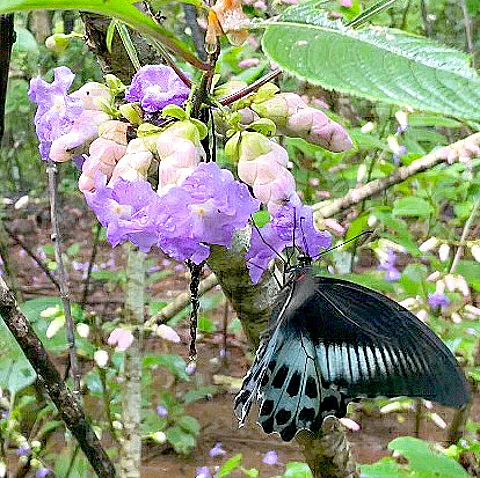

Strobilanthes callosa, Karvi, is endemic to the Western Ghats of India and the peninsular India. It is a shrub having elliptic leaves with alternate opposite arrangements. The flowers are like miniature funnels, looking downward. The buds are pink in color, which gradually unfolds to become purple-blue.
While proceeding from Goa to Belgaum, one can witness the slope along the Chorla Ghat is enchanting in blue glory. This year, the buds of Karvi along with a few flowering patches were noticed in August. Gradually, the inflorescence has now been enhanced with a huge number of flowers. A height of 3 - 4 meters long shrub standing upright bears flowers right from the ground level till the top, adorning the entire stem with two shades of color. The floor is laden with the fallen flowers and appears as a magnificent purple - blue carpet.
Vivekanand Environment Awareness Brigade recently organized ‘Karvi Pushpotsav’ at Mhadei Research Centre, Chorla Ghat to witness the incredible phenomenon of mass flowering as a huge number of flowers blossomed.
Akshatra Fernandes, a researcher and assistant professor at Ganpat Parsekar College of Education, Harmal, shared excellent knowledge. She says, “The Karvi shrubs grow from the seeds. It gathers and stores all the energy to bloom only once in a lifetime, after a wait of seven years. This is the strategy to attract their pollinators. Flowering together in huge numbers (synchronized mass blooming) brightens up the landscape, signalling the pollinators that the Karvi has blossomed.”
She cited the example of the plateaus of Goa, as the Rhamphicarpa fistulosa, Tutari, blooms only during sunset. The Karvi flowers too have a biological clock, and they blossom at the exact time after seven years. She adds, “The Karvi shrubs are known to move as per their comfort zone. They have adopted the roots that are spread around to seek essential elements. It also helps them withstand the wind, and it thus holds the land and prevents soil erosion.”
There are five species of Karvi recorded in Goa. All are endemic to Western Ghats, viz. Strobilanthes callosa, Strobilanthes heyneana, Strobilanthes integrifolius, Strobilanthes ciliata, and Strobilanthes ixiocephala. At the Chorla Ghat, one can witness two species of Karvi. Omkar Dharwadkar, a wildlife expert, says, “Strobilanthes heyneana’ is a common species on the high elevation of Chorla Ghat. It blooms every year. It is smaller in size and has white colour flowers with little shade of violet. It is locally known as ‘Vahyo.”
Rajendra Kerkar, an environmentalist, says, the mass flowering is the last stage of the life cycle of Karvi. After a few months, it dies. This shrub has a lot of importance in the pastoral community, Dhangar. The branches are very strong even after it dies. The Dhangar community of Goa has efficiently used these sticks to build their houses. The layer of mud was then applied over the sticks. This has helped to maintain the coolness inside the house.
Although the Karvi flowers do not have any fragrance, the mass flowering successfully invites a large number of honeybees and other creatures. The Karvi brings joy by offering sweetness to the wildlife. Its period of flowering is just for a month. The bees happily collect the nectar and store it in the honey hives. One can now find the honey hives built on several trees belonging to Terminalia species, including Madat, Kindal, Arjuna, and other trees.
Chaukul is a pristine village in Amboli, where the large patch of laterite plateau hosts the Karvi blossom. It is a real spectacle to see the vicinity of the Karvi blossom. There are 12–15 honeycombs on a single Alstonia scholaris tree. A visit to Karvi vegetation is a memorable experience.
Akshatra says, “Mass blooming attracts a large number of pollinator species of butterflies and moths. The life of every butterfly depends on the availability of the specific host plant. Karvi hosts five species of butterflies. One of these is the Sahyadri Oak Leaf Butterfly. It lays eggs on Karvi. This butterfly is known as a master of disguise because when it closes the wings, it resembles a dried leaf. When it feels threatened, it settles amid the leaf litter to camouflage. Its upper wings have an elusive blue colour. Like Karvi, the Sahyadri Oak Leaf Butterfly is also endemic to the Western Ghats of India. The other butterflies, including Malabar Spotted Flat and Blue Mormon prominently nectar on the flowers.”
Last year, the Karvi blossomed at Shigao of Dharbandora and Paikul of Sattari. The old generation shrubs of Karvi have released all their fluid and dried up completely. A few branches are still standing in the same position, and the decayed flowers are also visible. The rest have fallen on the ground. At the same time, a new generation of Karvi has already begun. After receiving the heavy monsoonal rain, the small plants of Karvi have grown on the ground. It will now take seven years to mature and bear flowers.
In 2022, Karvi appeared in Nirankal village in Ponda. It blooms at different times at different locations, but only after completing the lifecycle of seven years. This year, Sanjay Gandhi National Park, Borivali, which is surrounded by the metropolitan city of Mumbai on all four sides, also witnessed the Karvi blossom.
The Karvi festival organized at the height of more than 800 metres on the Chorla Ghat, displayed bewildering facets of the floral and faunal wealth that inspired one to launch a mission for its protection and conservation.
(Adv Suraj Malik is currently practicing in the District and Sessions court in Goa. As a member of Vivekanand Environment Awareness Brigade, Keri, he delivers lectures in schools to build a strong environmental consciousness among the students)